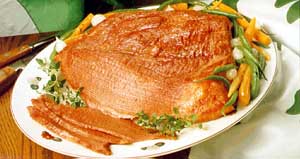-
- Atkins comes out on top in District 3 race
- Saldaña wins 76th Assembly Democratic nomination
- Aguirre top choice for city attorney
- EQCA chooses San Diego as site of new project
- Boy Scouts amend lawsuit against the city
- Murray Ramirez elected chair of Chief of Police’s GLBT advisory board
- Community News
-
- New Paltz mayor charged for issuing marriage licenses to GBLT couples
- Philly police officer comes out as transgender cop
- Mayor looks forward to arguing marriage equality before high court
- GLBT rights groups won’t make marriage a litmus test in election
- Californians oppose marriage for gays and lesbians, constitutional amendment
- Discrimination policy could cost Scouts big bucks
- National News Briefs
- World News Briefs
dining out
The skinny on corned beef
Published Thursday, 04-Mar-2004 in issue 845
The last time I made a corned beef it turned out like something you’d wear to LeatherFest. Yet the one I cooked two years ago was surprisingly luscious and fork tender.
Where you shop for this tough cut of beef – and how you make it – will determine whether you keep your teeth or lose them in the eating process. Consumers oftentimes gravitate to the leanest, reddish-looking roasts in the grocery stores, which are remarkably inexpensive at this time of year. But when it comes to everyone’s favorite St. Paddy’s Day treat, meat experts warn “the leaner the meaner.”
The rule of thumb is to choose cuts that sport an even slab of fat along one side. Look for thin threads of fat running through the meat on the other. And if your budget allows, spend the few extra bucks for choice-grade “point cuts,” which are sometimes available at major grocery stores, but readily found at select meat markets such as Iowa Meat Farms in Mission Gorge or Siesel’s Old Fashion Meats in Bay Park.
According to Stan Glenn, a supervisor at Iowa, “Commercial corned beef is injected with brine. Ours is barrel cured the old-fashioned way.” The meat, he adds, is also choice quality and sells for $3.99 a pound.
Many consumers may also be unaware that the term “corning” describes a form of curing – and has nothing to do with corn. The name originates from Anglo-Saxon times before refrigeration was available. The meat was dry-cured in coarse “corns” of salt during the mid-winter months and eventually became a traditional dish served for Easter dinner in rural Ireland. Today, the meal is reportedly more popular in the United States than in Ireland, served usually with cooked cabbage and root vegetables.
The options for preparing your prized cut of corned beef are varied, although the extended stovetop braising method tends to produce optimum results over baking or microwaving. For starters, the beef should reach an internal temperature of at least 160 degrees, which means cooking the roast at about one hour per pound in liquid or in the oven, or 20-30 minutes per pound in the microwave. And the roast should stand for about 10 minutes after it is removed from the heat, thus allowing the meat to retrieve some of its lost juices.
The corned beef I had successfully cooked involved a five-pound, choice cut of beef braised in equal parts water and beer. Simply place the roast in a large pot and cover it with the liquid. Add about 10 peppercorns and a few bay leaves and bring it all to a roiling boil. Then reduce the heat and simmer with a loose cover for at least one hour per pound. Add cut potatoes in the last 45 minutes of cooking, and carrots and cabbage in the last 25 minutes.
Also, be sure to slice the roast diagonally across the grain of the meat to avoid stringiness. And keep in mind that corned beef is usually still pink in color after it’s cooked due to the nitrites used in the curing process, which “fixes” the pigment. The offset color, however, is easily adjusted by placing the sliced corned beef (and a cup of its cooking liquid) into a roasting pan and then baking it for about 10-15 minutes at 275 degrees.
Leftover corned beef, when properly stored, stays good in the refrigerator for three to four days. Although when it turns out a winner, don’t expect to be making hash the next morning.
|
|
Copyright © 2003-2025 Uptown Publications



